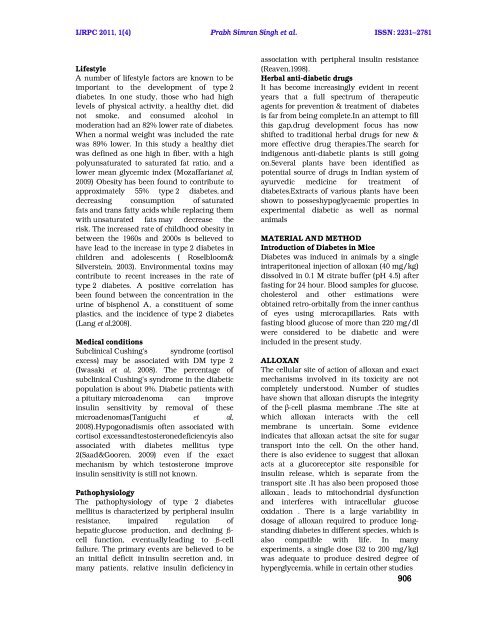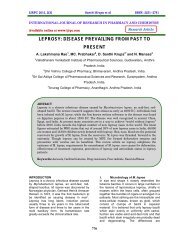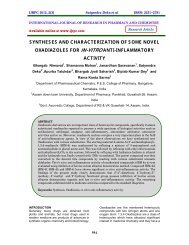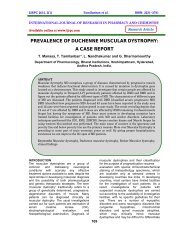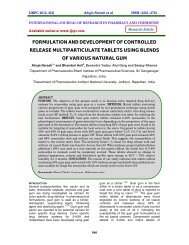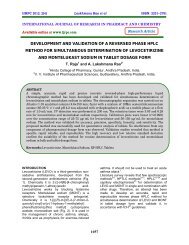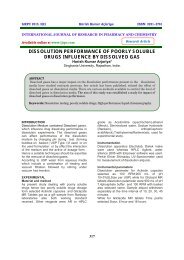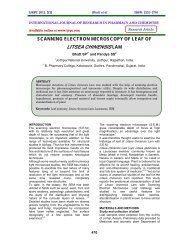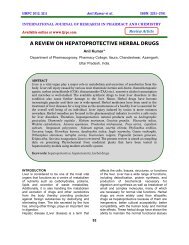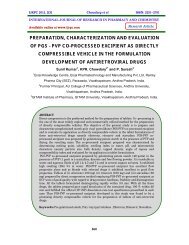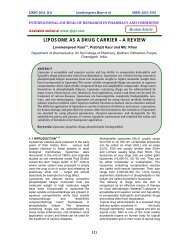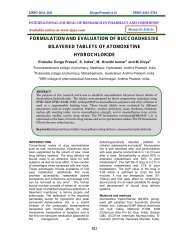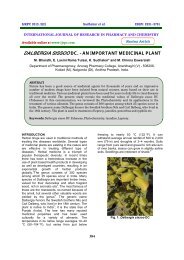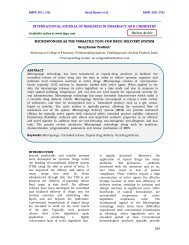evaluation of anti-diabetic activity of leaves of cassia ... - ijrpc
evaluation of anti-diabetic activity of leaves of cassia ... - ijrpc
evaluation of anti-diabetic activity of leaves of cassia ... - ijrpc
You also want an ePaper? Increase the reach of your titles
YUMPU automatically turns print PDFs into web optimized ePapers that Google loves.
IJRPC 2011, 1(4) Prabh Simran Singh et al. ISSN: 22312781<br />
Lifestyle<br />
A number <strong>of</strong> lifestyle factors are known to be<br />
important to the development <strong>of</strong> type 2<br />
diabetes. In one study, those who had high<br />
levels <strong>of</strong> physical <strong>activity</strong>, a healthy diet, did<br />
not smoke, and consumed alcohol in<br />
moderation had an 82% lower rate <strong>of</strong> diabetes.<br />
When a normal weight was included the rate<br />
was 89% lower. In this study a healthy diet<br />
was defined as one high in fiber, with a high<br />
polyunsaturated to saturated fat ratio, and a<br />
lower mean glycemic index (Mozaffarianet al,<br />
2009) Obesity has been found to contribute to<br />
approximately 55% type 2 diabetes, and<br />
decreasing consumption <strong>of</strong> saturated<br />
fats and trans fatty acids while replacing them<br />
with unsaturated fats may decrease the<br />
risk. The increased rate <strong>of</strong> childhood obesity in<br />
between the 1960s and 2000s is believed to<br />
have lead to the increase in type 2 diabetes in<br />
children and adolescents ( Roselbloom&<br />
Silverstein, 2003). Environmental toxins may<br />
contribute to recent increases in the rate <strong>of</strong><br />
type 2 diabetes. A positive correlation has<br />
been found between the concentration in the<br />
urine <strong>of</strong> bisphenol A, a constituent <strong>of</strong> some<br />
plastics, and the incidence <strong>of</strong> type 2 diabetes<br />
(Lang et al,2008).<br />
Medical conditions<br />
Subclinical Cushing's syndrome (cortisol<br />
excess) may be associated with DM type 2<br />
(Iwasaki et al, 2008). The percentage <strong>of</strong><br />
subclinical Cushing's syndrome in the <strong>diabetic</strong><br />
population is about 9%. Diabetic patients with<br />
a pituitary microadenoma can improve<br />
insulin sensitivity by removal <strong>of</strong> these<br />
microadenomas(Taniguchi et al,<br />
2008).Hypogonadismis <strong>of</strong>ten associated with<br />
cortisol excessandtestosteronedeficiencyis also<br />
associated with diabetes mellitus type<br />
2(Saad&Gooren, 2009) even if the exact<br />
mechanism by which testosterone improve<br />
insulin sensitivity is still not known.<br />
Pathophysiology<br />
The pathophysiology <strong>of</strong> type 2 diabetes<br />
mellitus is characterized by peripheral insulin<br />
resistance, impaired regulation <strong>of</strong><br />
hepatic glucose production, and declining ß-<br />
cell function, eventually leading to ß-cell<br />
failure. The primary events are believed to be<br />
an initial deficit in insulin secretion and, in<br />
many patients, relative insulin deficiency in<br />
association with peripheral insulin resistance<br />
(Reaven,1998).<br />
Herbal <strong>anti</strong>-<strong>diabetic</strong> drugs<br />
It has become increasingly evident in recent<br />
years that a full spectrum <strong>of</strong> therapeutic<br />
agents for prevention & treatment <strong>of</strong> diabetes<br />
is far from being complete.In an attempt to fill<br />
this gap,drug development focus has now<br />
shifted to traditional herbal drugs for new &<br />
more effective drug therapies.The search for<br />
indigenous <strong>anti</strong>-<strong>diabetic</strong> plants is still going<br />
on.Several plants have been identified as<br />
potential source <strong>of</strong> drugs in Indian system <strong>of</strong><br />
ayurvedic medicine for treatment <strong>of</strong><br />
diabetes.Extracts <strong>of</strong> various plants have been<br />
shown to posseshypoglycaemic properties in<br />
experimental <strong>diabetic</strong> as well as normal<br />
animals<br />
MATERIAL AND METHOD<br />
Introduction <strong>of</strong> Diabetes in Mice<br />
Diabetes was induced in animals by a single<br />
intraperitoneal injection <strong>of</strong> alloxan (40 mg/kg)<br />
dissolved in 0.1 M citrate buffer (pH 4.5) after<br />
fasting for 24 hour. Blood samples for glucose,<br />
cholesterol and other estimations were<br />
obtained retro-orbitally from the inner canthus<br />
<strong>of</strong> eyes using microcapillaries. Rats with<br />
fasting blood glucose <strong>of</strong> more than 220 mg/dl<br />
were considered to be <strong>diabetic</strong> and were<br />
included in the present study.<br />
ALLOXAN<br />
The cellular site <strong>of</strong> action <strong>of</strong> alloxan and exact<br />
mechanisms involved in its toxicity are not<br />
completely understood. Number <strong>of</strong> studies<br />
have shown that alloxan disrupts the integrity<br />
<strong>of</strong> the β-cell plasma membrane .The site at<br />
which alloxan interacts with the cell<br />
membrane is uncertain. Some evidence<br />
indicates that alloxan actsat the site for sugar<br />
transport into the cell. On the other hand,<br />
there is also evidence to suggest that alloxan<br />
acts at a glucoreceptor site responsible for<br />
insulin release, which is separate from the<br />
transport site .It has also been proposed those<br />
alloxan , leads to mitochondrial dysfunction<br />
and interferes with intracellular glucose<br />
oxidation . There is a large variability in<br />
dosage <strong>of</strong> alloxan required to produce longstanding<br />
diabetes in different species, which is<br />
also compatible with life. In many<br />
experiments, a single dose (32 to 200 mg/kg)<br />
was adequate to produce desired degree <strong>of</strong><br />
hyperglycemia, while in certain other studies<br />
906


